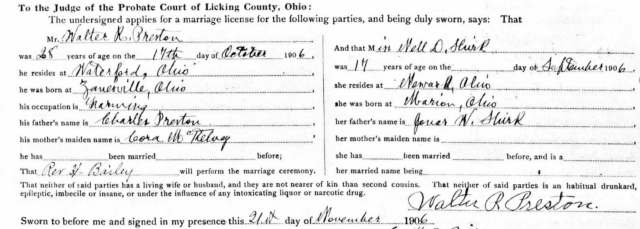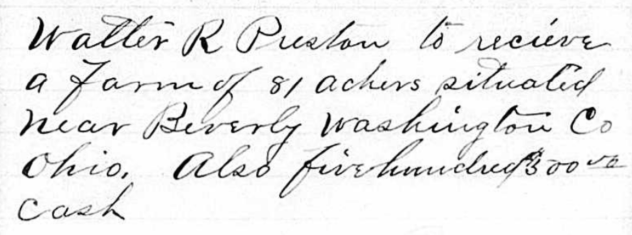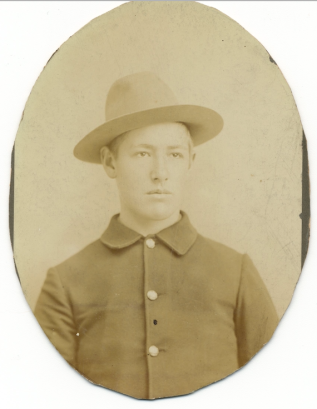I have shared a few stories about my Father’s Father’s side of the family on this blog. In some recent posts, I highlighted the Althausers, Prestons, Sears, Robinsons, and Dixons, all of whose stories have plenty of interesting turns and surprises. For me, one of the most exciting surprises, and earliest genealogy victories, was finding a great uncle that I didn’t know existed on that side of the family.
In an earlier post, I mentioned that my Dad is a fourth generation only son, so there are very few relatives on that side of the family. On the wives’s sides, many of their siblings either stayed single or never married, so no cousins were produced. Therefore, I was very familiar with the names of the odd great aunt or uncle.
All of my life, I heard about my great great grandmother, Jessie (called grandmother Robinson by my Dad) and her sister, Bertha (called Aunt Bert). Aunt Bert married but never had children, and after Jessie’s husband died, she moved in with Aunt Bert. My grandmother and my Dad knew them both, so I’ve heard plenty of stories about the sisters and their husbands.
My family also has lots of pictures of Jessie, Aunt Bert, and their parents, Charles and Cora Preston. While sorting through some of these family pictures, I found several of a very handsome young man who greatly resembled Charles, but I had absolutely no idea who he could be as all the other males relatives were accounted for. What made the photos even more tantalizing were that many of them were taken at photography studios in Nashville around the same time that Jessie, Bert, and their parents were having their photos taken in Nashville. Who WAS THIS?!
As I began going though other Preston documents, I found two letters written by Cora to Charles in 1882. Charles was living in Nashville and in the process of moving Cora and Jessie down. Cora made a mention of “the children” and what they were up to. Now this was very odd. In 1882, Jessie was six years old, but Aunt Bert wasn’t born until 1886. So, either I had Aunt Bert’s birthday completely wrong, or there was another child born between the two sisters, one I had never heard of before. Was this child the mysterious boy and man in the photographs?
This mystery is one of the reasons I first signed up for Ancestry.com. I wanted to search the census records to see if there was anything that I didn’t know or that my family didn’t know or had forgotten. The first census year I checked was 1880. With any luck, the mystery child was born prior to the census date. Here is what I found:

As you can see, the Prestons are living in Zanesville, Ohio: Charles, Cora, Jessie, and….Walter? Who is Walter? According to the census, Charles and Cora had a 1 year old son named Walter. He is very likely the other child to whom Cora was referring to in her letter. Surprise 1: Cora and Charles had a child named Walter who was completely unknown to me and my parents.
Now I had more questions. Did this Walter die young? Is that why we didn’t know about him? Or did he live, and was he the mystery man in the photos?

Without the 1890 census, I moved on to the 1900 census in Nashville, Tennessee. There, I found Charles, Cora, and Aunt Bert living together. No Walter. However, check out the last two columns. Either Charles or Cora reported to the census taker that Cora gave birth to 3 children, and ALL 3 CHILDREN WERE STILL LIVING. Wow, now wasn’t that a bombshell?!
So Walter WAS alive, but where was he living? He was not living with his sister, Jessie, and her family, so I assumed he must be living somewhere else in Nashville. After some searching, I found the following entry in the 1900 census:

This Walter was the best candidate for my Walter in Nashville. The birth year was about right and he worked as a moulder, the same line of work which his father and grandfather were in. They had been married for 3 years (about 1897) and had no children. A search of the Nashville City Directories showed Walter Preston in 1896 working as a moulder at the Phillips and Buttorf Manufacturing Company, the same company that Charles worked for as the foreman. In 1895, Walter was listed as living in the same household as Charles and Cora. I think I found their son. Surprise 2: Walter was still alive in 1900.
Walter, His Wives, and His Children
On 6 July 1897, Walter married his first wife, Clara Jackson, in Nashville. However, their marriage didn’t last. In April 1898, Clara filed for divorce from Walter. The newspapers cited failure to provide, but the divorce petition also listed not being faithful and cruelty.
The divorce was put on hold when Walter enlisted in the Spanish American War and was shipped off to San Fransisco for training. In October 1898, the First Tennessee Infantry left for the Philippines, where Walter saw action during the Philippine insurrection. Walter finally returned to Nashville in 1901 with the rest of the First Tennessee after 3 years in the army. During his service, Walter got into some trouble which resulted in a disease that contributed to health problems that he battled for the rest of his life.
In June 1902, Clara finally received her divorce from Walter. Clara moved back in with her parents, and Walter also returned to live in his parents’ house. In about 1905, Walter left Nashville and moved to Waterford, Ohio where he married his second wife, Nellie Shirk. Below is the marriage record:

The next year, Charles Preston died in Nashville, and named Walter as his son in his will. He left Walter a farm in Beverly, Ohio as well as some money.

The marriage record and the will showed that Walter was indeed the son of Charles and Cora McKelvey and was very much alive. Below is part of the 1920 census, which shows Water, wife Nellie, and two daughters Ruth and Cora, living in Cleveland, Ohio.

Nellie Preston died in 1923, and as Walter was in such bad health, he sent his two daughters to live with their maternal grandparents. Walter’s health continued to deteriorate, and he finally died in 1927 while living in a home for veterans.
The Photographs
After these revelations – Charles and Cora had a third child, Walter reached adulthood, Walter was married twice and had two children – I took another look at some of the family photographs. There were several photographs labeled Cora and Ruth, who I now knew were Walter’s children. The girls were very distinctive looking, which helped me identify a photograph of their mother, Nellie, standing with the same handsome man, though a bit older, holding a baby in his lap. This was most definitely a photograph of Nellie and Walter. This photograph helped me determine that the other photographs of the same man were in fact Walter, Jessie and Aunt Bert’s brother.
This photo shows Walter in his wool uniform from the Spanish-American War. (Knowing that he served also helped identify that this man was Walter) The original photo was cut in a circle, likely to fit into a frame. I assume this photo sat in either Charles and Cora’s house or in Jessie’s.

This photograph shows Walter as a very fashionably dressed young man. It was taken soon after Walter moved back to Ohio. I think this is my favorite photograph of him!

Conclusion
I thoroughly enjoyed learning about Walter, the uncle I never knew about. I have a couple of theories as to why we never heard about Walter. First, he died in 1927, before my grandfather was even born. Second, he lived in Ohio for half of his life, and it is doubtful that he ever came back to Tennessee. Third, he lived a bit of a wild lifestyle, and maybe Jessie and Aunt Bert tried to hide that fact. They did a fairly good job of keeping family secrets under wraps. I found out that Jessie did keep in touch with Walter’s children, particularly Ruth, and that Ruth visited Jessie on a couple of occasions. But, for whatever reason or reasons, Walter’s memory just disappeared.
After I told everyone about Walter, they were all so astonished. But the funniest part was after I found all of this out, I asked my grandmother if she had ever heard that Jessie and Aunt Bert had a brother, and she said, “oh yes, I kind of remember that now.”
Nice to meet you, Uncle Walter!















